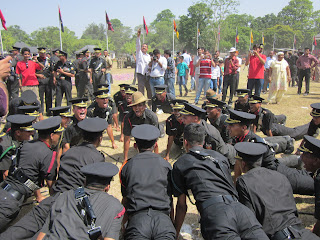With "frank" Indo-Pak talks on the issue of Siachen Glacier – the highest battlefield in the world – failed to reach any resolution due to Islamabad's non-willingness to climb down from its position, the June 18-19 negotiations on Sir Creek falling between Indian Kutch region and Pakistan's Sindh province are likely to meet the same fate.
According to sources, when Defence Secretary Shashikant Sharma met his Pakistani counterpart Nargis Sethi in the Garrison city of Rawalpindi" frank exchange of views" took place. Sharma is said to have told the Pakistani delegation that the history of Indo-Pak relations especially in the light of Kargil conflict in 1999, does not advise any "drastic" change at the 72-km-long Siachen Glacier.
"The Defence Secretary also informed the Pakistani delegation, which was keen for demilitarization of the Glacier, that in the light of historical precedence the Indian government's position is very difficult and any withdrawal would become very difficult to explain to its citizens as Pakistan has proved to be untrustworthy time and again," sources said.
"Even as Pakistan had been making noises of reaching a resolution on the Siachen Glacier issue in the aftermath of losing 130 soldiers in a massive avalanche, it was not willing to accede to our demand of authenticate the present troop positions on the ground," sources added.
Now all eyes are on the June 18 talks on about 100-km long Sir Creek that will be held in New Delhi. The Sir Creek dispute consists of three parts – a land boundary from Rajasthan to Gujarat, the water channel and the maritime boundary. While the land boundary is more or less agreed upon, the delineation of boundary in Sir Creek channel is the main bone of contention with the maritime boundary also hinging upon it. Sir Creek is important as it will decide the Exclusive Economic Zone in the sea falling in both
country's control and the ability to use the Creek waterway for naval and civil shipping.
The dispute has been about a 100 year-old. In 1913 for the first time the area was contested by Rao Saheb of Kutch and Chief Commissioner of Sindh. The Government of Bombay gave a verdict in 1914, which forms genesis of the Sir Creek dispute between India and Pakistan post independence in 1947.
While Pakistan has been citing Paragraph 9 of the verdict to claim that boundary lies to the east of Sir Creek implying that the region belongs to Pakistan. India, on the other hand, cites Paragram 10 that indicates that the Creek remains navigable for the complete year and brings in international Thalweg principle. As per this principle, if a water body between two countries is navigable for the most of the year the boundary has to be fixed in its middle and it is to be divided between the two countries equally.
The negotiations on the issue received a major boost as the two countries agreed to conduct a joint hydrographic survey of the area to ascertain its navigability. The Creek was found to be entirely navigable by naval units of both the countries and the report finding was Okayed by both the sides.
According to officials in 2008, however, Pakistan did another flip-flop and refused to accept the established navigability and thus the applicability of Thalweg principle.
Vice Admiral (retd) BR Rao, who as Chief Hydrographer of the country was part of the joint survey conducted by the two countries in 2007 told the Defence Express, "In my personal opinion the main channel of Sir Creek will be difficult to resolve because of democratic government on both sides making giving away of even one inch of land inconceivable. One can presume that the resolution of main channel will only by political masters."
Vice Admiral Rao who has been part of negotiations of maritime boundary disputes with Bangladesh and Myanmar, suggested delinking of the maritime boundary issue that will decide the Exclusive Economic Zone from the land boundary dispute. "Maritime boundary starts from where land boundary ends.
But in absence of a land reference point I advised to delineate maritime boundary seawards. Both the countries had agreed on boundary from 200 nautical miles away from coast to 150 nautical miles towards the land.
"During this time Musharraf (Pakistan President) was keen to resolve the maritime boundary issue. In fact the Pakistan delegation told us that they could resolve the maritime boundary issue in 5-10 minutes but they would like to consider all the three issues in composite, which means the solution will not be anytime soon."
Over a period of time the geography of the region as also changed with the channel of the Creek changing its course to westwards. Citing this Pakistan in the 2011 Sir Creek talks staked claim on the mouth of Sir Creek and the adjoining creek on India side known as Pir Sanai creek. The land mass dividing Peer Sanai Creek and Sir Creek in old maps has disappeared over these years. The unreasonable position of Pakistan derailed the talks last year, with only take away was the willingness to meet again.
The Peer Sanai Creek is important for India as it is used by its naval
assets. Pakistan's control over the mouth of the Creek would give it a leverage to block it for use by Indian warships and merchant vessels. In the 2011 talks a critical Indian concession also did not find favours with Pakistan. As the Channel of Creek changed its course to West and equal division of the water body would have meant a closer boundary with Sindh province much to the discomfort of Pakistan. Keeping this in mind India conceded to ignore the westward lunge of the channel and divide it equally
from the middle.

































